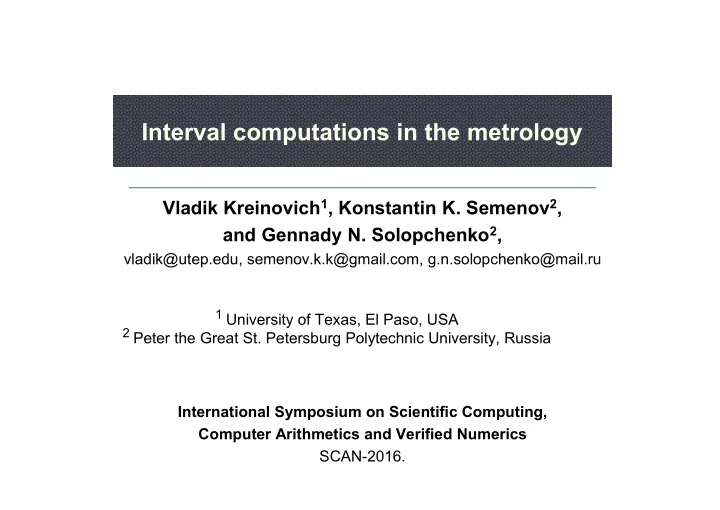

Interval computations in the metrology Vladik Kreinovich 1 , Konstantin K. Semenov 2 , and Gennady N. Solopchenko 2 , vladik@utep.edu, semenov.k.k@gmail.com, g.n.solopchenko@mail.ru 1 University of Texas, El Paso, USA 2 Peter the Great St. Petersburg Polytechnic University, Russia International Symposium on Scientific Computing, Computer Arithmetics and Verified Numerics SCAN-2016.
SCAN-2016 Introduction: measurements The main property of any measurement result is its uncertainty or error . It is the main quality parameter for performed measurement. Let us measure some voltage quantity x real . Let us receive x measured = 1.05 V from measuring system. Is it close to the real value x real ? To answer how accurate it is, one has to estimate its absolute error x = x measured – x real . 1
SCAN-2016 Introduction: measurements We never know the measurand real value x real . We never know the error value x. The only thing we , x x can do is to use interval of its possible values. Its bounds can be retrieved from technical documentation for used measuring instrument. If we process data obtained from measurements then we will get in principle inaccurate results. We need always to estimate the transformed uncertainty inherited from the initial data errors. Otherwise we will incorrect in our further reasoning that will be based on these results. 2
SCAN-2016 Measurements results processing Metrological case is specific. Classical approaches for uncertainty propagation always provide bounds J[ x] for estimated interval , x x that guarantees its coverage: . J x x , As a conclusion J is almost always overestimated, sometimes catastrophically. In metrology we can allow J to be slightly over- or even slightly underestimated because of results’ rounding. 3
SCAN-2016 Measurements results processing Linearization can be used. Let y f x x be a function to process the , ..., 1 n measurement results . Then x ..., x , 1 n n f x x 1 ..., , y n x i x 1 i i Function f is determined by computer program. To obtain its partial derivatives we can use automatic differentiation technique. We can take into consideration only linear operations ! with measurement errors in interval computations in metrology. 4
SCAN-2016 The heat consumption metering One of the most natural examples for interval computations applying in metrology is the heat consumption metering. The Part 1 of the acting European standard EN- 1434 introduces the following simple formula to determine the heat consumption during the time interval from 0 to 1 : τ 1 Q M τ h τ d τ τ 0 where Q is the consumed heat quantity, M ( ) is the mass flow-rate of the heat-carrier (water) in the time moment , h ( ) is the enthalpies difference between hot water on the house heating system inlet and cooled water on its outlet. 5
SCAN-2016 The heat consumption metering All the variables included in the formula for the heat quantity are the measurements results and are inaccurate. The typical structure of heat-metering system includes 6 sensors. The typical heat exchange circuit is below: 6
SCAN-2016 The heat consumption metering Typical heat-meter structural scheme contains digital data processor that calculates the heat quantity. 7
SCAN-2016 The heat consumption metering Each of used sensors passed the metrological tests and has the certificate on its accuracy. The obtained values of the direct measurements are used to calculate the consumed heat quantity. The corresponding computing of the heat quantity Q is processed on the base of the legislatively fixed formulas, like this: Q M h h M M h h 1 1 2 1 2 2 с M ρ V , M ρ V where are the accumulated masses 1 1 1 2 2 2 of the heat-carrier that passes in the forward and return flows; and 1 and 2 are the densities of the water in these flows; h 1 , h 2 , h c are the enthalpy values in the forward and return flows and also the enthalpy of the cold water. 8
SCAN-2016 The heat consumption metering The acting standard EN-1434 contains the following requirements for the accuracy of used sub-assembles. ! where other processed measured quantities? In the cited fragment, ΔΘ min = 3 ˚С , q is the measured value of the water flow and q p is the maximum permissible value of the water flow range. Unhopefully, the list of the sub- assemblies doesn’t refer to the analog-to-digital converters 9
SCAN-2016 The heat consumption metering The essential defect of the standard EN-1434 is that it demands to compute the arithmetic sum of the relative errors of the initial data used to calculate the consumed heat quantity Q . This is incorrect. Here is the referred fragments of the standard . The typically used formula for the heat quantity is Q M h h M M h h 1 1 2 1 2 2 с ! Q M M h h h 1 2 1 2 c ! γ γ γ γ γ γ Q M M h h h 10 1 2 1 2 c
SCAN-2016 The heat consumption metering If we take into account the inaccuracy only of the part of the initial data then we underestimate the uncertainty of the consumed heat quantity Below the results of the numeric examples are presented obtained with interval computations. If we take into account all data uncertainty If we take into account only temperature uncertainty as it is recommended in EN-1434 11
SCAN-2016 The heat consumption metering One more numeric example (for the case when there are leakages in hot water heating) We see drastic underestimation of the consumed heat quantity uncertainty. Red lines are the results of Monte-Carlo tests to check the reliability of obtained results If we take into account all data uncertainty If we take into account only temperature uncertainty as it is recommended in EN-1434 12
SCAN-2016 Thank you for attention!
Recommend
More recommend